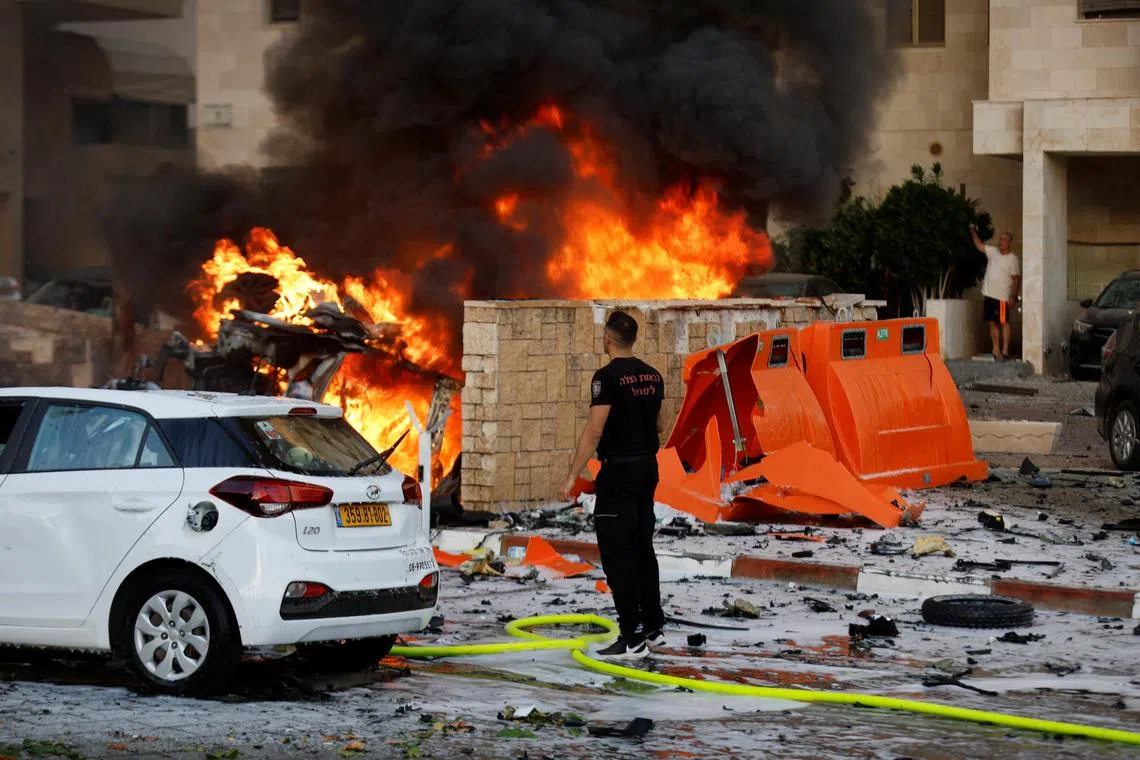Hamas’ motivations behind assault on Israel
Militant group’s strategic calculations in launching the attack are uncertain, but it is likely that considerations went beyond just tit-for-tat revenge.
Sign up now: Get ST's newsletters delivered to your inbox

Hamas launched a surprise assault on Israel on Saturday morning by air, land and sea, beginning with a barrage of more than 2,000 rockets.
PHOTO: REUTERS
Eyal Mayroz
Follow topic:
Almost 50 years ago to the day, Israel had failed to anticipate the outbreak of the 1973 Yom Kippur war – a shock attack on its borders by a coalition of Arab states.
Now, it appears the country’s intelligence apparatuses have fallen victim to a false sense of security
The belief, widely shared across Israeli society, that the Hamas militant group would avoid a large-scale military confrontation with Israel to protect itself and spare further suffering and harm to the residents of Gaza was shattered by a surprise assault on Saturday morning by air, land and sea.
The attack began with a barrage of more than 2,000 rockets fired into Israel. Under the cover of the rockets, a large-scale, carefully coordinated, ground operation set out from Gaza and attacked more than 20 Israeli towns and army bases adjacent to the strip.
Israeli losses are certain to increase in the coming hours and days.
Israel’s military reserves have commenced a massive mobilisation
Calculations behind the attack
As in the case of the Yom Kippur war, numerous analyses and investigations will be undertaken in the coming weeks, months and years on the intelligence, operational and political failures that allowed the Hamas attack to unfold. The assault was apparently undetected by Israel initially, and then for hours met with either insufficient or unprepared Israeli forces.
Similar to the 1973 war, the purposefully chosen timing of a Sabbath and the Jewish holiday of Sukkot provide initial, though very partial, clues to the breakdown.
Hamas’ strategic calculations in launching the attack are uncertain at this stage. However, the assured severity of Israel’s retaliation against the group
Kidnapping Israelis for prisoner swops with Hamas militants jailed in Israel, for instance, has been among the most highly desired objectives of the group’s military operations in the past.
In 2011, a single Israel soldier, Gilad Shalit, who had been held captive in Gaza since 2006, was exchanged for more than 1,000 Palestinian prisoners. Among these prisoners was Yahya Sinwar, Hamas’ current leader in Gaza, who had served 22 years in an Israeli jail.
The reports of dozens of Israelis being taken captive
Another broader objective for Hamas may have been to undermine the ongoing negotiations between the United States and Saudi Arabia
Thwarting these talks would be a significant boon for Iran, a key backer of Hamas, and its allies. While Teheran has said it supports the attacks by Hamas against Israel, it remains uncertain at this point whether Iran or Hezbollah – the militant group in Lebanon that has a growing partnership with Hamas –would open additional fronts against Israel in the coming days.
Any escalation in the conflict from either Iran or Lebanon would be highly problematic for Israel. The same would apply if the war with Hamas further exacerbates the already high tensions and violent clashes between Israel and Palestinian militant groups in the West Bank.
What could happen next?

A plume of smoke rises in the sky of Gaza City during an Israeli airstrike on Oct 9.
PHOTO: AFP
Named Iron Swords, Israel’s retaliatory offensive against Hamas in Gaza is likely to last a long time. The challenges it faces are massive.
Along with the need to restore the trust of the Israeli public and resurrect Israel’s smashed military deterrence against Hamas and other foes, Prime Minister Benjamin Netanyahu’s government will likely have to deal with other complexities:
The fate of potentially dozens of Israeli hostages;
The significantly elevated risks for Israel’s forces should a ground incursion be carried out; and
The threats of escalation on other fronts, including Lebanon, the West Bank, and mixed Jewish-Palestinian cities inside Israel.
International support for an aggressive operation could also become difficult to retain amid a mounting toll of civilian Palestinian casualties.
The current round of violence has barely started,
As noted, the Israelis will consider it critically important to reclaim their country’s military deterrence capabilities against Hamas, which in the eyes of many, may necessitate a military takeover of Gaza. This would bring more devastating outcomes for Gaza’s civilian population.
For many Palestinians, last weekend’s events offered Israelis a small taste of what their own lives have been like under decades of occupation. However, the early celebrations will likely soon turn into anger and frustration as the numbers of Palestinian civilian casualties will continue to rise. Violence begets violence.
In the short and medium terms, the trauma of Hamas’ surprise attack is bound to have momentous consequences for Israel’s domestic politics.
It’s still too early to assess the likely many long-term impacts of the attack on Israelis
In his 2022 memoir, Bibi: My Story, Mr Netanyahu wrote about his decision during Israel’s Pillar of Defence operation against Hamas in 2012 to avoid an Israeli ground assault in Gaza.
Such an attack, he warned, could lead to many hundreds of Israeli Defence Force casualties and many thousands of Palestinian casualties – something he was adamantly against. He did authorise ground incursions on two other occasions (operations Cast Lead in 2008 and Protective Edge in 2014). But his cautious tendencies prevailed in other cases, at times, in the face of strong pressure.
Arguably, the weekend’s national trauma and the radical make-up of Mr Netanyahu’s right-wing government
Eyal Mayroz is senior lecturer in peace and conflict studies at the University of Sydney. This article first appeared in
The Conversation.

